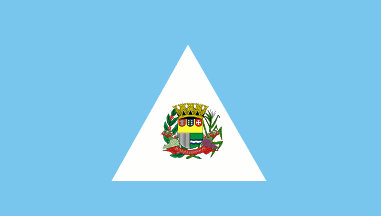 image by Dirk Schönberger,
29 November 2012
image by Dirk Schönberger,
29 November 2012Source: http://www.junqueiropolis.sp.gov.br/bandeira.php

Last modified: 2012-12-29 by ian macdonald
Keywords: sao paulo | junqueirópolis |
Links: FOTW homepage |
search |
disclaimer and copyright |
write us |
mirrors
 image by Dirk Schönberger,
29 November 2012
image by Dirk Schönberger,
29 November 2012
Source:
http://www.junqueiropolis.sp.gov.br/bandeira.php
A light blue flag with a white triangle in the centre, bearing the municipal arms.
Official website at
http://www.junqueiropolis.sp.gov.br
Dirk Schönberger,
29 November 2012
Junqueirópolis is named for Álvaro de Oliveira Junqueira, who founded the settlement on 13 June 1945 on a piece of land, then part of the municipality of Lucélia, located on a hill separating the basins of rivers Peixe and Feio. Originally named Patrimônio Junqueira, the settlement was renamed Junqueirópolis (from Greek "polis", "a town") in 1947. The municipality of Junqueirópolis was established by Law No. 233 of 24 December 1948.
The flag of Junqueirópolis is prescribed by Law No. 1,010 of 30 May
1978.
The flag is celeste blue, in the middle a white equilateral triangle,
the municipal coat of arms being "placed aesthetically" inside the
triangle.
Celeste blue represent the rivers flowing in the municipality, the
profuse water supply and the sky over our country.
White represents peace in which the people of Junqueirópolis aspire to
live and prosper.
The equilateral triangle represents:
1. God, the Fatherland and the Family, as a symbol of our faith, of
our love to Brazil, and of the veneration of the human family.
2. Liberty, Equality, and Fraternity, as the essence of the democratic
regime place under the rule of the Law.
3. The Judiciary System, the Legislature and the Executive, as the
three powers.
4. The three races that colonized the municipality: white, yellow, and
black.
The coat of arms shall be represented as prescribed by the relevant Law.
The construction details of the flag are: 1. 20 units in length on 14 units in height. 2. The center of the rectangle coincides with the center of the triangle. 3. The triangle is inscribed within an imaginary circle of 6.5 units in radius. 4. The crossing point of the circle with the bisection of the [...] is the upper vertex of the triangle.
The coat of arms represented in the middle of the flag has the following construction details: - 1. The midpoint of the lower edge of the upper quarter coincides with the center of the triangle and of the rectangle; this line is parallel to the base of the triangle, while the line that divides the lower quarter is a perpendicular between the parallels. http://www.junqueiropolis.sp.gov.br/downloads/leis_bandeira_junqueiropolis.pdf - Law on the flag
Photos of the flag indicate that the shade of blue appear to vary
across the copies of the flag.
http://www.pibjunqueiropolis.com.br/fotos/details.php?image_id=179
http://www.pibjunqueiropolis.com.br/fotos/details.php?image_id=52
http://www.clikadao.com/4/category/osmar%20pinato/1.html
The coat of arms of Junqueirópolis was originally prescribed by Law No. 247 of 10 May 1961. The coat of arms is described as follows: 1. Portuguese classic shield, surmounted by a mural crown representative of municipalities, divided [horizontally] into two quarters, the lower being divided [vertically]. 2. In the first quarter, on a field or, three escutcheons placed in chief. 3. In the dexter escutcheon, on a field gules, a jacket of the São Paulo pioneers proper. In the median escutcheon, [six] bezants or on a field azure. In the sinister escutcheon, on a field gules, a Cross of the Order of Christ. 4. In the second quarter, dexter, a field argent paly vert, sinister, on a field vert two parallel rivers. 5. Supporters, dexter, a branch of coffee, sinister, a branch of cotton. 6. A scroll, on a field gules the motto "LABOR ET DIVITIAE". http://www.junqueiropolis.sp.gov.br/downloads/leis_brasao.pdf - Law on the coat of arms
The coat of arms was amended by Law No. 1,141, adopted in 1981. The
supporters and scroll were changed. Law No. 2,108 of 21 May 2002
abrogates the two previous Laws and prescribes the today's coat of
arms as follows:
1. Portuguese classic shield, surmounted by a mural crown
representative of municipalities, divided [horizontally] into two
quarters, the lower being divided [vertically].
2. In the first quarter, on a field or, three escutcheons placed in
chief.
3. In the dexter escutcheon, on a field gules, a jacket of the São
Paulo pioneers proper. In the median escutcheon, [six] bezants or on
a field azure. In the sinister escutcheon, on a field gules, a Cross
of the Order of Christ.
4. In the second quarter, dexter, a field argent paly vert, sinister,
on a field vert two parallel rivers.
5. Supporters, dexter, a branch of coffee, a branch of acerola and a
bunch of [white] grapes, sinister, a sugar cane, a branch of acerola
and a bunch of [purple] grapes.
6. A scroll, on a field gules the motto "JUNQUEIRÓPOLIS".
http://www.junqueiropolis.sp.gov.br/brasao.php - Municipal website
The changes in the supporters reflect the recent changes in the local agriculture. Junqueirópolis is today known as "The Capital of Acerola", being the first producer in São Paulo State. Production is about 2,450 tons per year. Acerola (Malpighia emarginata DC) is a tropical shrub aka Barbados cherry or West Indian cherry, grown for its fruits very high in vitamin C. http://edis.ifas.ufl.edu/mg041 - Presentation of acerola, University of Florida website
Accordingly, the flag must have been changed in 1981 to reflect the change in the coat of arms.
Oddly enough, the supporters of the coat of arms appears to have been
swapped on the reverse of the flag, at least on the copy shown on a
photo.
http://www.pibjunqueiropolis.com.br/fotos/details.php?image_id=176&sessionid=65798bb2afb2384f73af903d16be2bb5
Ivan Sache, 1 December 2012